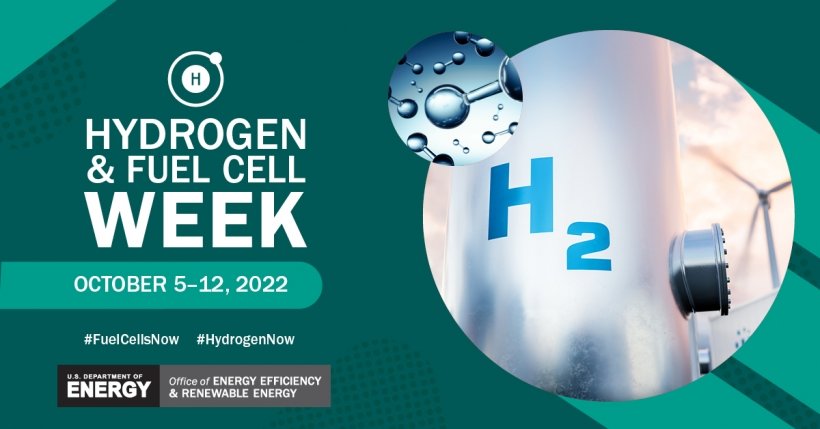
What do hydrogen’s atomic weight and October 8 have in common? The answer is in the numbers: 1.008 is the atomic weight of hydrogen, which can be shortened to 10/08 as a calendar date.
That’s why October 8 is designated as National Hydrogen and Fuel Cell Day—an annual opportunity to celebrate hydrogen and its role in the transition to a cleaner and more equitable energy future.
Clean hydrogen—which is produced with zero or near-zero emissions from renewables, nuclear energy, or natural gas with carbon sequestration—has tremendous potential in this energy future. It can function as an energy-storage medium and as fuel for many transportation applications that are difficult to decarbonize and where battery electric approaches may be impractical. Clean hydrogen can also help to decarbonize high-emissions industrial processes that currently use fossil fuels directly or hydrogen produced from natural gas without carbon sequestration.
Today, hydrogen is used for producing fertilizer, refining petroleum, steelmaking, and processing foods—it’s even used in the makeup industry. In the United States, we produce approximately 10 million metric tons of hydrogen annually for use in such processes, but most of that hydrogen comes from natural gas, resulting in substantial CO2 emissions. Using clean hydrogen instead can dramatically reduce environmental impacts while helping to grow clean-hydrogen production capacity and expand the necessary infrastructure, which will reduce costs across the value chain and enable additional applications.
In the coming years, clean hydrogen has the potential to play an essential role in our everyday lives. It can store energy, capturing excess wind and solar power and feeding that energy back to the electrical grid when there’s no wind or sunshine. This regeneration can help stabilize the grid and enable expansion of variable renewable power generation, ensuring a reliable and resilient supply of electricity for our homes and businesses as we realize the vision of zero-emissions electricity. Hydrogen can also be used to fuel zero-emissions ships, airplanes, trucks, and buses that move people and goods over oceans, across continents, and even around local neighborhoods.
Hydrogen technologies are growing across multiple sectors. For example, in the United States today there are more than 620 megawatts (MW) of installed or planned electrolyzers, which produce hydrogen using electricity to split water. We have more than 50,000 hydrogen-powered forklifts moving goods in warehouses with zero emissions, and more than 500 MW of backup-power fuel cells—many of which are hydrogen-fueled— producing electricity during blackouts for critical applications like data centers. While hydrogen technologies have come a long way over the last several years, costs and other challenges to at-scale adoption need to be addressed for clean hydrogen to realize its full potential in our national energy system.
The Department of Energy (DOE) Hydrogen and Fuel Cell Technologies Office (HFTO), in collaboration with the DOE Hydrogen Program, is working to unlock hydrogen’s potential to decarbonize multiple sectors in our economy, create economic opportunities that lift up communities, and help meet President Biden’s climate goals. Through collaborative initiatives such as the DOE Hydrogen Shot, H2@Scale, and the recently launched H2Hubs, HFTO is bringing together DOE offices and government agencies and engaging with stakeholders across the country to target strategic, high-impact uses for clean hydrogen; reduce the cost of technologies; and focus on regional networks to drive the scale of clean hydrogen applications while creating economic opportunities for American communities. Historic investments in clean hydrogen, including $9.5 billion from the Bipartisan Infrastructure Law and clean hydrogen production tax incentives from the Inflation Reduction Act, will also turbocharge efforts to make clean hydrogen accessible for all Americans.
And the U.S. is not alone in this effort. More than 25 national governments around the world have released a hydrogen roadmap and another 20 have a roadmap in development. Global initiatives with active participation from the United States—including the International Partnership for Hydrogen and Fuel Cells in the Economy, the Clean Energy Ministerial’s Hydrogen Initiative, and Mission Innovation’s Clean Hydrogen Mission—are bringing countries together to innovate, collaborate, and deploy clean hydrogen solutions.
As we kick off this week-long celebration of National Hydrogen and Fuel Cell Day, we hope you’ll join us by helping others learn more about clean hydrogen and the challenges and opportunities that lie ahead. Here are a few examples of how you can participate on October 8 and throughout the week:
- Follow EERE on Facebook, Twitter, and LinkedIn, and share something new you’ve learned about hydrogen tagging #NationalHydrogenDay #FuelCellsNow and #HydrogenNow in your post.
- Walk or run 1.008 miles and share a photo on social media tagging #H2DayWalk and #H2DayRun.
- Watch Secretary Granholm tell you all about clean hydrogen!
- Test your H2IQ by taking the hydrogen and fuel cell quiz and challenge your friends to do it as well.
- Mark your calendar on October 6 at 12:30 p.m. ET for a special extended edition H2IQ Hour webinar highlighting workforce development efforts with Historically Black College and Universities and Minority Serving Institutions.
- Read DOE’s new clean hydrogen roadmap to accelerate hydrogen production, infrastructure, and use in support of a net zero economy
- Apply to hydrogen and fuel cell jobs at HFTO.
Read the most up to date Fuel Cell and Hydrogen Industry news at FuelCellsWorks




